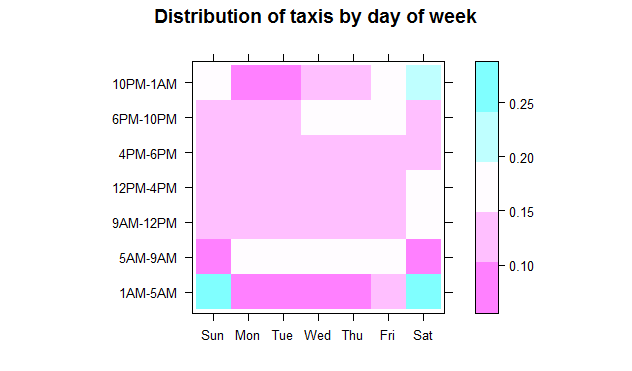Examining the new columns
Let's examine the new columns we created to make sure the transformation more or less worked. We use the rxSummary function to get some statistical summaries of the data. The rxSummary function is akin to the summary function in base R (aside from the fact that summary only works on a data.frame) in two ways:
- It provides numerical summaries for numeric columns (except for percentiles, for which we use the
rxQuantilefunction). - It provides counts for each level of the factor columns.
We use the same formula notation used by many other R modeling or plotting functions to specify which columns we want summaries for. For example, here we want to see summaries for pickup_hour and pickup_dow (both factors) and trip_duration (numeric, in seconds).
rxs1 <- rxSummary( ~ pickup_hour + pickup_dow + trip_duration, nyc_xdf)
# we can add a column for proportions next to the counts
rxs1$categorical <- lapply(rxs1$categorical, function(x) cbind(x, prop = round(prop.table(x$Counts), 2)))
rxs1
Call:
rxSummary(formula = ~pickup_hour + pickup_dow + trip_duration,
data = nyc_xdf)
Summary Statistics Results for: ~pickup_hour + pickup_dow + trip_duration
Data: nyc_xdf (RxXdfData Data Source)
File name: yellow_tripdata_2016.xdf
Number of valid observations: 69406520
Name Mean StdDev Min Max ValidObs MissingObs
trip_duration 933.9168 119243.5 -631148790 11538803 69406520 0
Category Counts for pickup_hour
Number of categories: 7
Number of valid observations: 69406520
Number of missing observations: 0
pickup_hour Counts prop
1AM-5AM 3801430 0.05
5AM-9AM 10630653 0.15
9AM-12PM 9765429 0.14
12PM-4PM 13473045 0.19
4PM-6PM 7946899 0.11
6PM-10PM 16138968 0.23
10PM-1AM 7650096 0.11
Category Counts for pickup_dow
Number of categories: 7
Number of valid observations: 69406520
Number of missing observations: 0
pickup_dow Counts prop
Sun 9267881 0.13
Mon 8938785 0.13
Tue 9667525 0.14
Wed 9982769 0.14
Thu 10398738 0.15
Fri 10655022 0.15
Sat 10495800 0.15
Separating two variables by a colon (pickup_dow:pickup_hour) instead of a plus sign (pickup_dow + pickup_hour) allows us to get summaries for each combination of the levels of the two factor columns, instead of individual ones.
rxs2 <- rxSummary( ~ pickup_dow:pickup_hour, nyc_xdf)
rxs2 <- tidyr::spread(rxs2$categorical[[1]], key = 'pickup_hour', value = 'Counts')
row.names(rxs2) <- rxs2[ , 1]
rxs2 <- as.matrix(rxs2[ , -1])
rxs2
1AM-5AM 5AM-9AM 9AM-12PM 12PM-4PM 4PM-6PM 6PM-10PM 10PM-1AM
Sun 1040233 740157 1396409 1980752 1032434 1697529 1380367
Mon 304474 1630951 1268326 1838143 1133728 2096219 666944
Tue 278407 1840134 1382381 1882356 1151837 2390506 741904
Wed 313809 1854757 1417953 1880896 1142071 2508618 864665
Thu 354646 1871828 1428985 1922502 1165535 2634023 1021219
Fri 553159 1766482 1406979 1922542 1173163 2516285 1316412
Sat 956702 926344 1464396 2045854 1148131 2295788 1658585
In the above case, the individual counts are not as helpful to us as proportions from those counts, and for comparing across different days of the week, we want the proportions to be based on totals for each column, not the entire table. We ask for proportions based on column totals by passing the 2 to as second argument to the prop.table function. We can also visually display the proportions using the levelplot function.
levelplot(prop.table(rxs2, 2), cuts = 4, xlab = "", ylab = "", main = "Distribution of taxis by day of week")

Interesting results manifest themselves in the above plot:
- Early morning (between 5AM and 9AM) taxi rides are predictably at their lowest on weekends, and somewhat on Mondays (the Monday blues effect?).
- During the business hours (between 9AM and 6PM), about the same proportion of taxi trips take place (about 42 to 45 percent) for each day of the week, including weekends. In other words, regardless of what day of the week it is, a little less than half of all trips take place between 9AM and 6PM.
- We can see a spike in taxi rides between 6PM and 10PM on Thursday and Friday evenings, and a spike between 10PM and 1AM on Friday and especially Saturday evenings. Taxi trips between 1AM and 5AM spike up on Saturdays (the Friday late-night outings) and even more so on Sundays (the Saturday late-night outings). They fall sharply on other days, but right slightly on Fridays (in anticipation!). In other words, more people go out on Thursdays but don't stay out late, even more people go out on Fridays and stay even later, but Saturday is the day most people choose for a really late outing.